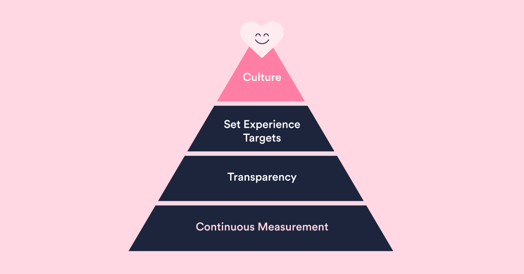Employee, or end-user, experience management is a hot topic in IT, particularly when a productivity-based view of experience is taken – i.e. how an IT device or service, or an engagement with IT support, helps or hinders an employee with the work they need to do.
This focus on experiences and productivity makes sense for many IT service providers, given that the traditional approach of cutting IT costs year-on-year, while good for the IT bottom line, might adversely affect business operations and outcomes. It’s potentially suboptimal decision making, where a dollar saved in every IT support engagement might cost the employee being helped, and the business as a consequence, far more than this.
So, experience management sounds like a great addition to existing IT management practices, but where does an experience-management newbie start? To help, this blog shares 15 practical tips for IT service providers, and their personnel, looking to measure and improve their delivered employee experience.
15 tips for getting started with IT Experience Management
- Start as soon as possible, and before change, not after it
Some customers say, “We’ll start with this after we make some changes.” Whereas we recommend that the best time to start experience management is always before making changes, not after.
- Introduce experience management with specific goals in mind
These goals will likely differ by organization, but it’s important to remember that experience measurement and management are about improvement. If you’re starting it because it’s the latest IT trend, a good thing to do, or to make the IT service provider look good, then you’re not best positioned to make the most of the opportunity.
- Understand that the successful introduction of experience management requires a culture change
Yes, operational and performance management changes will bring about better experiences and outcomes, but there needs to be an accompanying culture change for the best success. One that starts with recognizing and committing to improving how employees, or end-users, are impacted by the technology and support services they use. This change can be thought of as building a human-centric culture in IT, where decisions are made to create value for end users.
- Be honest about the cost of introducing experience management (plus get the necessary funding)
While using experience management will improve employee productivity and business operations and outcomes, which deliver both cost and revenue improvements, the IT service provider might incur additional costs (with other business functions receiving the associated financial benefits, not IT).
- Identify the key business stakeholders for experience management
These business stakeholders will not only contribute to the scope of your experience management activities, but they’ll also likely be the recipients of experience-focused reporting and analytics (in a format that best suits their needs) and be involved in prioritizing potential improvement activities.
- Agree on a definition of what experience management means to your organization
First, there are many different definitions of what experience management is online. Second, and importantly, your organization’s focus on experience management – and, therefore, its definition – must be tailored to what it wants or needs to achieve. It’s essential to “get everyone on the same page.”
- Recognize that traditional IT metrics fail to provide experience-based insight
There are so many issues with traditional IT metrics. For example, these metrics are often a supply-side, rather than demand-side, view of what’s important. Consequently, they tend to be focused on the “mechanics” of IT service delivery and support, such that they’re focused on operational elements such as “how many” and “how long.” This approach measures what has been done rather than the outcomes, i.e. what has been achieved through what has been done. The result is a perception gap between how well the IT service provider thinks it is doing and how end users view the provider’s performance. Then additionally, these traditional IT metrics are likely to encourage IT personnel to focus on the wrong things, encouraging inappropriate behaviors.
- Don’t underestimate how long experience improvement will take
Employee experience improvement is not something that happens overnight. In particular, the necessary culture change will require time. So, ensure that plans reflect this and manage stakeholders’ expectations accordingly.
- Create an experience baseline (and do it now)
Not only to understand the experience “status quo,” i.e. what end users currently think of the IT service provider but also to provide a point from which to assess improvements and achievements over time.
- Set appropriate experience management targets
These targets are what your organization would like to achieve over the next three months, six months, or even a year. They focus IT’s planned improvement work, and importantly, should be set out in terms of what matters most to end users.
- Be prepared to see a drop in feedback “positivity” versus what the traditional metrics show
This temporary drop is inevitable. People would rightly question the need to introduce experience management capabilities if it wasn’t. Think of this as finally getting insight into what’s working well and what isn’t. It’s not all bad news, though, because our customers, on average, find that 82% of feedback is positive, i.e. a 9 or a 10 in net promoter score (NPS)-scoring terms.
- Start to identify improvement areas (including “quick wins”)
As with other opportunities for continual improvement, these should be prioritized based on business needs (often pain points), costs, organizational change capacity, and other factors. There will likely be some quick wins that can be focused on initially to help promote experience management as a critical corporate improvement capability.
- Don’t overlook the motivational opportunity of continuous real-time experience data
For example, service desk analysts can receive near-real-time positive feedback on their efforts that, unlike traditional metrics and data, is the validation of how they’re helping their business peers (rather than simply knowing how quickly they’re working).
- Move the focus of periodic service review meetings from traditional IT metrics to what matters most to end users
Access to experience management data allows service reviews to focus on the issues end users are experiencing rather than the traditional metrics highlighting that the “mechanics”-focused service-level targets are being met. It’s tackling what the IT industry calls “watermelon service level agreements (SLAs)” that are green on the outside but red on the inside – with the issues hidden by IT’s measurement of the wrong things.
- Use experience measurement to help assess the impact of experience management introduction
As mentioned in the first tip above, experience measurement is a great tool for understanding the end-user impact of changes as they happen – with the ability to course-correct as needed based on how the changes affect the end-user experience and productivity.
These tips contribute to an IT service provider climbing up the experience-management pyramid shown in the image below, where each step builds upon the foundations laid by the last.

The more widely experience is measured and shared, the more effectively your IT service provider can identify issues and improve its operations and outcomes. Then, if needed, once your organization has reached a good enough level of maturity in experience management, it can complement its traditional SLAs with experience level agreements (XLAs).
Ready to start driving IT Experience Management in your organization? See how HappySignals ITXM Platform enables you to measure the end-user experiences and productivity.




